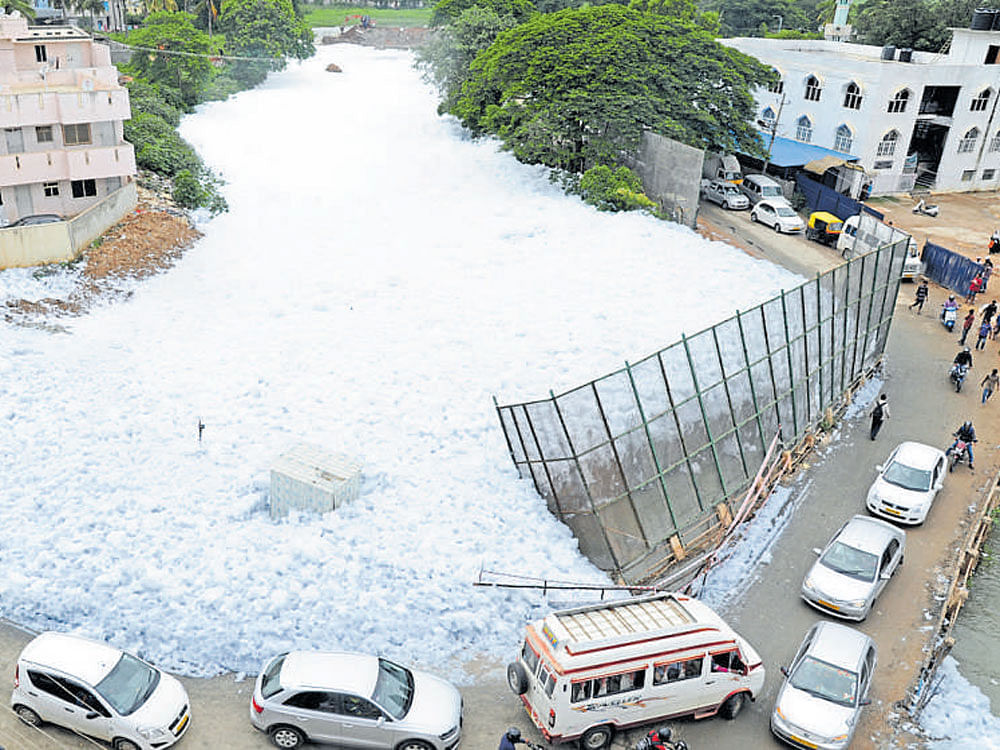
A government-appointed expert committee has suggested short- and long-term measures to rejuvenate Bellandur lake, the largest but most polluted waterbody in Bengaluru.
Looking into the reasons for the pathetic condition of the lake, its polluters and pollutants, the committee found that the waterbody had come to suffer abnormal levels of pollution in terms of septicity, obnoxious odour, aerosols with toxic volatile organic compounds, eutrophication, breeding of mosquitoes, disappearance of native fish species, algal bloom and profuse growth of invasive exotic aquatic microphytes.
The committee, headed by Additional Chief Secretary (Urban Development Department) Mahindra Jain, has flagged the carrying of sewage, garbage and debris from stormwater drains into the lake.
In the short term, the committee has recommended regular harvesting of microphytes, stopping dumping of waste, evicting all waste-processing units in the vicinity of the lake, wastewater treatment plant at all apartments around the lake, regular maintenance of water quality details, installation of surveillance cameras and surprise environment audit mechanism. It also suggested free passage of water, ban on phosphorous in detergents or regulation of its use and improving aeration by installing a fountain.
The committee has asked the Revenue Department to map the lake, identify its boundary and buffer zone as per the National Green Tribunal (NGT) order and remove encroachments. It also suggested identification of common land, kharab land (wasteland), streams and drains.
As long-term measures, the committee has suggested installing sewage treatment plants (STPs) of 90 million litres per day (MLD) at Ammanikere, 60 MLD at Koramangala and Challaghatta valleys and 150 MLD to treat water from Koramangala and Ejipura drains, 2 MLD at Halasuru lake, 55 MLD at Hulimavu, Sarakki, Chikka Begur and Agara lakes.
This apart, the committee has recommended cancelling the allotment of 40 acres of land made by the Karnataka Industrial Areas Development Authority (KIADB) between Agara and Bellandur lakes. The land should instead be used for setting up an STP of 410 MLD. The committee also suggested setting up of an additional decentralised STP and one-time cleaning of Bellandur lake. It has recommended relocating a slum that has encroached on the lake land, its buffer zone and wetland area.
The committee felt that the lake can be developed as a secondary source of water for Bengaluru, which can be used for large construction projects.
The committee has laid emphasis on citizens’ lake monitoring system and notification of these monitoring committees. These committees must meet every three months.
The legal cell should be strengthened to deal with the litigations that may hamper the lake’s rejuvenation. It has called for caution in granting consent to large-scale projects in the lake’s catchment areas.
The committee has given 13 points for the success of the rejuvenation of the lake and warned that too many parastatal agencies and lack of coordination could mar the revival efforts. It stressed the need for an integrated agency with statutory and financial autonomy, which should own, maintain and take action against the polluters. It has also underscored the need for an effective judicial system for speedy disposal of civil disputes involving the lake land.
DH News Service